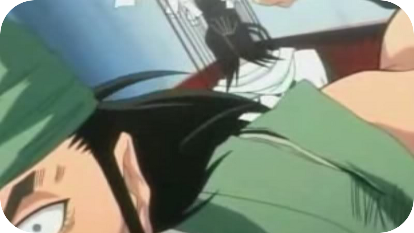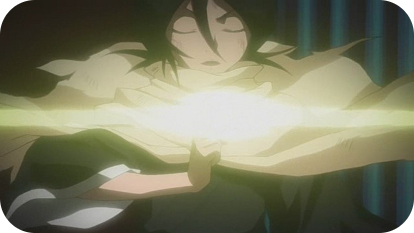Post by Darake Kitoushi on May 3, 2013 1:13:39 GMT -5

Zanpakutō : Soul Cutters The supernatural weapon carried by the shinigami. A manifestation of the user's soul in physical form. When an individual first begins training at the Shino Academy, they are each given identical blades called an asauchi. Keeping this katana with them at all times, gradually it will begin to change in appearance with the shinigami unknowingly imprinting themselves to it. This results in the shaping and molding of a unique sword which becomes their sealed zanpakutō. This change could include a coloring of their wrappings, a distinct pattern on the handguard, or even a change of the length of the blade such as becoming a wakizashi. The possibilities are endless as every one is unique and these changes are a reflection of their soul. This zanpakutō literally becomes a part of them, an extension of their being.
Eventually at a point in their training in which could happen at any moment, but particularly a time of dire need or inner conflict, they will be contacted by a spirit. This spirit is in reality their zanpakutō and more importantly a manifestation of their soul. These spirits cannot be seen by anyone else and through speaking cryptically serve to guide a shinigami towards self-realization. Time may stop or slow to a crawl as the shinigami is mentally taken to their inner world which is similarly a reflection of their inner soul. This world could take any appearance and is not bound by any logic of the real world such as gravity operating by entirely different rules. The first step towards realizing one's potential lies with a test or inquiry to reveal the name of his zanpakutō which like all interactions with their inner spirit involves some form of self-discovery. Upon this important moment of learning the name, one may speak it out loud preceded by a unique incantation or command called a Kaigo; it in a manner hinting at the zanpakutō's power.
This then releases the zanpakutō into it's initial release called a Shikai. A radical transformation occurs into a distinctive new weapon with it's form and abilities perfectly suited to it's owner. While every shikai is unique, they can be classified into particular categories. A shinigami's goal is to attain harmonization with their zanpakutō and the most efficient way to do this is to perform Jinzen, a state of calm meditation with their blade placed in front of them or in their lap. Though this, they may enter their inner world and speak directly with their spirit. Here they may train by combating with the spirit to gain greater harmony within themselves and be taught new abilities to utilize with their zanpakutō. It is crucial to note that injuries sustain in the inner world with reflect upon their real bodies, but this meditative state is so deep they remain unmoved.
The ultimate ambition of this training is to create such a perfect balance within themselves that they unlock the highly revered final release called Bankai. This transformation realizes a shinigami's full potential through materialization and summoning their spirit into the physical world. Those who can utilize bankai are exceedingly rare as even within the exceptionally talented four high noble families, who innately posses a great deal of power, only have a member capable of gaining one every few generations. Even after the rare occurrence of achieving one, because of the extreme amount of reiryoku involved and released, they are difficult to control. Thus it requires dedicated intensive training in the physical world for ten years before it can be properly utilized in actual combat. The actual form which a bankai can take are remarkably unique to every individual with it's capabilities a meaningful representation of the individual's soul. It is notable that these forms always follow an almost elegant theme of their shikai, as if it was a hint to the full capabilities of the zanpakutō. While bankai are drastically different from each other there are a few common traits such as they are always massively large and seem to follow four known categories.
Releasing one's zanpakutō takes time and giving an opponent a chance to react should be taken into consideration.

Hohō : Fast Movement The skill in which shinigaimi are able to manipulate spirit particles under their feet. The basics of this technique are crucial to any soldier as this allows them to create invisible platforms outside of Soul Society in which to stand on air and give the appearance of flight. The foremost of hohō techniques in which all strive to attain and some begin to master is that of shunpo, flash steps. With a burst of energy this creates a burst of acceleration making the target appear as if they have nearly teleported by skipping a single step faster than the normal eye can follow. Those of higher level advance this technique to travel further distances and be able to see the use of the skill in the enemy as to be not caught off guard.
When using shunpo it should always be taken into consideration that an opponent could react with their own high-speed technique. Thus your actions after a shunpo should not be so elaborate without consulting with the other player first. Additionally the energy required for shunpo should be kept in mind with speed, distance, and consecutive use making it more taxing.

Kidō : Demon arts One of the four basic shinigami combat forms of the shinigami graded in power from 1 to 99 raising in difficulty to cast. Taught in the Shino Academy extensively, not everyone, particularly those with an aptitude for combat, will not be able to master some of the even middle ranged spells. The higher range elude some of even the most expert spell casters in Soul Society. Each requires that first the energy be summoned up through the method known as a chant specific to the particular spell. This can also make it more likely for the spell to backfire hurting yourself as will having a low stat in comparison to the power of the spell. Types of kido are divided into two categories of mastery, each that involve different talents and training specific to certain techniques. Offensive spells are called Hadō, involving destructive or explosive forces such as energy which typically mimics fire or electricity. Defensive spells are classified as Bakudō and involve shields and binding forces which protect the user or stop the enemy.
Eishōhaki (Incantation Abandonment) - This technique is well known among those versed with kidō and allows for a spell to be casted immediately and without the need for an incantation. This however weakens the spell, exactly how much determined by the spells number in relation to the highest that one is capable of casting. Attempting this with spells at the limits of one's capability will have disastrous results such as causing it to backfire or explode.
Nijū Eishō (Twofold Incantation) - This advanced technique allows the caster to start the incantation to one spell and when halfway through, to insert the incantation to a second spell before finishing the first. This then allows for the second spell to be fired immediately after the first. Learning this technique is very difficult and should only be attempted by those who specialize in kidō
Kōjutsu Eishō (Spoken-After Incantation) - This extremely advanced technique allows for an incantation to be spoken after casting the spell in order to further strengthen it. Learning this technique requires incredibly diligent training and should only be attempted by those with a mastery of their field.
Casting kidō takes time and giving an opponent a chance to react should be taken into consideration. Furthermore the energy required to cast should always be considered, particularly when casting consecutively.
Requirements:
New System
#1-10: 2 boxes total in both specific kidō attribute and intelligence
#1-15: 3 boxes total in both specific kidō attribute and intelligence
#1-20: 4 boxes total in both specific kidō attribute and intelligence
#1-25: 5 boxes total in both specific kidō attribute and intelligence
#1-30: 6 boxes total in both specific kidō attribute and intelligence
#1-40: 7 boxes total in both specific kidō attribute and intelligence
#1-60: 8 boxes total in both specific kidō attribute and intelligence
#1-85: 9 boxes total in both specific kidō attribute and intelligence
#1-99: 10 boxes total in both specific kidō attribute and intelligence
[*By specific kidō this means either hadō or bakudō. Boxes in hadō don't contribute to bakudō or vice versa.]
[*It is important to consider the primary stat for casting is still hadō/bakudō. Thus even though you can cast higher spells if say you have 5 intelligence and 1 hadō/bakudō, your spells will still be incredibly weak and ineffective.}
Old System
#1-10: Any Rank and 5 in the corresponding stat.
#1-25: Any Rank and 10 in the corresponding stat.
#1-40: Any Rank and 15 in the corresponding stat.
#1-55: Any Rank and 20 in the corresponding stat.
#1-70: Any Rank and 25 in the corresponding stat.
#1-85: Any Rank and 30 in the corresponding stat
#1-10: Captain Rank and 5 in the corresponding stat.
#1-25: Captain Rank and 10 in the corresponding stat.
#1-45: Captain Rank and 15 in the corresponding stat.
#1-65: Captain Rank and 20 in the corresponding stat.
#1-85: Captain Rank and 25 in the corresponding stat.
#1-99: Captain Rank and 30 in the corresponding stat.



